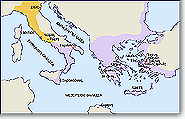In most regions of Greece the transition from the Geometric ceramic tradition to the new orientalizing disposition and later to the development of the local Archaic workshops came about gradually. In Eastern Greece many local workshops developed, with  those of Miletus and Clazomanae of particular note and the works of which spread throughout the larger part of the Mediterranean and the Black Sea, whereas at the same time they gave an impetus to the creations of the Ionian colonists in Italy. However, the most important centre of ceramics during the 7th century B.C. was Corinth, which, after inventing the black-figure technique, provided the means for the development of accuracy and expressiveness in pottery. These elements were processed by the Athenian ceramists in proto-Attic style, which led to the formation and development of black-figure style in Athens. Around the middle of the 6th century B.C., the masterpieces of Attic ceramics already prevailed over their competitors in every market. The appearence of the red-figure style, which was a purely Athenian inspiration, did not indicate the end of the old technique. Black-figure vases continued to be reproduced for another half century, and the Panathenians amphoras continued for a much longer period. From the ceramics of that period we draw our information about the major painting, since we know only a few other examples of it.
those of Miletus and Clazomanae of particular note and the works of which spread throughout the larger part of the Mediterranean and the Black Sea, whereas at the same time they gave an impetus to the creations of the Ionian colonists in Italy. However, the most important centre of ceramics during the 7th century B.C. was Corinth, which, after inventing the black-figure technique, provided the means for the development of accuracy and expressiveness in pottery. These elements were processed by the Athenian ceramists in proto-Attic style, which led to the formation and development of black-figure style in Athens. Around the middle of the 6th century B.C., the masterpieces of Attic ceramics already prevailed over their competitors in every market. The appearence of the red-figure style, which was a purely Athenian inspiration, did not indicate the end of the old technique. Black-figure vases continued to be reproduced for another half century, and the Panathenians amphoras continued for a much longer period. From the ceramics of that period we draw our information about the major painting, since we know only a few other examples of it.
Besides the forementioned cities, written ceramics were reproduced in other region of Greece as well, such as in Cyclades, Argos, Euboea, Laconia and Boeotia.



















 those of Miletus and Clazomanae of particular note and the works of which spread throughout the larger part of the Mediterranean and the Black Sea, whereas at the same time they gave an impetus to the creations of the Ionian colonists in Italy. However, the most important centre of ceramics during the
those of Miletus and Clazomanae of particular note and the works of which spread throughout the larger part of the Mediterranean and the Black Sea, whereas at the same time they gave an impetus to the creations of the Ionian colonists in Italy. However, the most important centre of ceramics during the